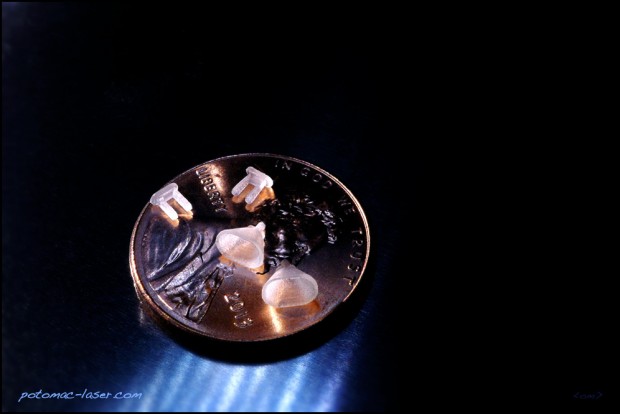
Potomac Photonics used micro 3D printing to help create middle ear protheses. Image courtesy of Potomac Photonics.
Latest News
May 1, 2015
 To manufacture the prostheses, researchers found micro 3D printing to be the most efficient. Image courtesy of Potomac Photonics.
To manufacture the prostheses, researchers found micro 3D printing to be the most efficient. Image courtesy of Potomac Photonics.3D printing is frequently in the news as a process for manufacturing prostheses to replace lost limbs. It’s an obvious choice, especially when combined with 3D scanning, because it allows designers to create prosthetics customized to each patient’s unique physical requirements.
At Potomac Photonics, experts in micro-manufacturing solutions, they are also finding more and more unique applications to micro 3D print small implantable prosthetics using the ProJet 3500 3D printer. In one recent project they were asked to make the tiny elements of the middle ear to help develop prosthesis for otosclerosis disease.
The ProJet 3500 uses MultiJet printing technology to deliver robust, durable high-quality plastic parts and has layer accuracy as small as 32 microns. The platform has a range of material choices including acrylonitrile butadiene styrene-like plastic; translucent, blue and black materials; and choices of high-strength, highly flexible and very tough plastics. This makes it suited to highly accurate prototypes and end use parts of many kinds and sizes, including automotive, aerospace, and, of course, medical devices.
According to the American Academy of Otolaryngology – Head and Neck Surgery [AAO-HNS], hearing is a complex process that is dynamic in nature. The eardrum transfers vibrations from sound waves to three tiny bones in the middle ear. It is the stapes, commonly called the stirrup bone, that sets the inner ear fluids in motion, starting the sensory process of hearing.
NIH’s National Institute on Deafness and Other Communication Disorders explains that otosclerosis is an abnormal hardening of body tissue. In the lifelong regeneration of new bone tissue, occasionally abnormal “remodeling” of bone occurs. If the abnormal bone remodeling is around the stapes bone it will become fixed, which inhibits its ability to generate the vibrations needed for proper hearing.
AAO-HNS estimates that a full 10% of the world’s adult Caucasian population is affected by otosclerosis, and NIH puts the number of U.S. cases at over 3 million. There are no drug treatments, hearing aids only work in mild cases, and most people are diagnosed while in their 20s, so it is a lifelong problem. Consequently, it is important to try to develop prosthesis solutions.
Monika Kwacz, a researcher at the Institute of Micromechanics and Photonics at Warsaw Technical University in Poland has been studying the results of stapedotomy surgery, leading to her team’s development of new stapes prostheses. “Intuitively,” says Kwacz, “it seemed to me that 3D printing would be the best technology for first prototyping. We need the first prototypes to experimentally verify that the device geometry was well designed and we will be able to implant the device in a temporal bone. If the geometry is good, then we will check the mechanical operation of the device. However, if we find we do need to modify the device geometry, 3D printing provides an easy way to modify in the CAD design step.”
Kwacz had tried another 3D printing process but it could not meet the precise requirement of the stapes design. Using a 3D Systems ProJet 3500 high-resolution 3D printer, Potomac was able to get the very small, precise geometries she needed with tight tolerances. Turnaround, even shipping to Europe, was quick.
Given the small size of the parts, short 3D printed production runs may also be economically viable once the design is proven. In the meantime, Potomac Photonics will be working with Kwacz to micro 3D print a solution that will literally bring music to the ears of many otosclerosis suffers.
More Info:
Subscribe to our FREE magazine, FREE email newsletters or both!
Latest News
About the Author
DE’s editors contribute news and new product announcements to Digital Engineering.
Press releases may be sent to them via [email protected].






